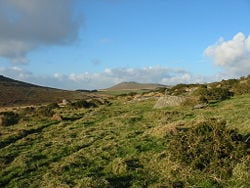Pixie
Pixies are mythical creatures of English folklore, considered to be particularly concentrated in the areas the downs and moors of Devon and Cornwall. Like Sprites and other different types of English Faeries, pixies are often considered mischevious, but not overtly malevolent creatures of nature.
Etymology
In regional dialect, these mischievous little folk are sometimes referred to as piskies/piskeys or the little people.Due to the pranks they were renowned for playing on humans, the term "pixilated" developed, meaning a person who cannot see clearly due to confusion. Later, this term came to be used for digital imagery that was compromised of small boxs of color known as "pixels".[1]
Description
Pixies are usually depicted as wingless, with pointed ears, and often wearing a green outfit and pointed hat. Sometimes their eyes are described as being pointed upwards at the temple ends. They are said to enjoy playing tricks on people, for example by stealing their belongings or throwing things at them. At night, they steal horses and bring them back before dawn, leaving only tangled manes as evidence of the prank. Some pixies are said to exude pixie dust, which is left in their footprints or floating behind them as they fly.
Pixies can be repelled by objects made from iron or iron ore as contact with the metal is said to harm them, another trait they share in common with other fairies of the British Isles.
Origin
The first to write extensively about pixies was Mrs. Anna Eliza Bray in "The Borders of the Tamar and the Tavy", 3 vol. (1837).[2] Before then, pixies were part of the long-standing oral tradition found in Great Britian that also included the similar Faeries. Because of this, it is difficult to determine how exactly the idea of the pixie was first conceptialized and when.
One myth states that pixies were a race of people who were not good enough for Heaven or bad enough for Hell and were therefore forced to remain on Earth forever. Another legend claims that they were Druids who resisted Christianity and were subsequently sentenced by God to grow smaller and smaller until they accepted Christianity.[3]
It has been speculated by some medical professionals that the legends of pixies and elves, was inspired by a genetic disorder known as Williams syndrome. Some of these afflicted have pointed ears and sloe eyes and elongated faces that make them look like "real" pixies and the syndrome is often called "Pixieism."
On Dartmoor, in Devon, travellers who became lost on the moor were sometimes said to have been "pixie led," in other words, deliberately led astray by the little people. It is said that, if travellers felt the onset of the pixie spell, they can turn their coats inside out to confuse them and escape, a technique normally used for all fairies.
Those who deliberately follow pixies often vanish without a trace. For example, a farmhand at Rowbrook, situated on the steep, wooded flanks of the River Dart valley, is said to have been lured down towards the river by mysterious voices, calling his name: ‘Jan Coo.’ He was never seen again.
Even within living memory, some rural families left small gifts, such as bowls of food or saucers of milk, for the pixies in order to placate them. When shown this respect and attention, pixies would sometimes even help the family by tidying up the household during the night.
Recent folklore
In some regions, belief in pixies has endured into contemporary times. During the construction of Hinkley Point nuclear power station, anything that went wrong was blamed on "the Pixy," with the station being built near Wick's Barrow, an Iron Age burial mound called "Pixies Mound" by the locals.
After construction was completed, the contractors presented the station manager with a garden gnome, representing the Pixy. On the one occasion the ornament was removed from the station's trophy cabinet, the station was closed down by a freak flood.
There were reports in 2001 of pixie sightings in the UK in the Woodham area of County Durham. All of these sightings were from residents of houses in a small street near a meadow called "Carwadine Close."
In modern popular culture
Template:Cleanup-section (And some of them should moved to disambiguation page for Pixie)
Pixies commonly appear in popular culture. Fantasy books and movies such as The Black Cauldron feature the creatures. In film, their first appearance was in the 1912 film As Others See Us.Holly Black's Spiderwick Chronicles Harry Potter and the Chamber of Secrets'Peter Pan Eoin Colfer's Artemis Fowl series.
Notes
- ↑ (2007). In Encyclopædia Britannica. ["Pixie"]Retrieved June 19, 2007, from Encyclopædia Britannica Online.
- ↑ (2007). In Encyclopædia Britannica. ["Pixie"]Retrieved June 19, 2007, from Encyclopædia Britannica Online.
- ↑ Encyclopedia Mythica from Encyclopedia Mythica Online.["Pixie"]Accessed June 19, 2007
ReferencesISBN links support NWE through referral fees
External links
Credits
New World Encyclopedia writers and editors rewrote and completed the Wikipedia article in accordance with New World Encyclopedia standards. This article abides by terms of the Creative Commons CC-by-sa 3.0 License (CC-by-sa), which may be used and disseminated with proper attribution. Credit is due under the terms of this license that can reference both the New World Encyclopedia contributors and the selfless volunteer contributors of the Wikimedia Foundation. To cite this article click here for a list of acceptable citing formats.The history of earlier contributions by wikipedians is accessible to researchers here:
The history of this article since it was imported to New World Encyclopedia:
Note: Some restrictions may apply to use of individual images which are separately licensed.
